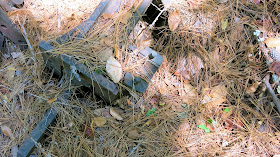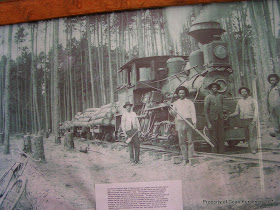I just returned from my third excursion down to the Southern Forest Heritage Museum in Longleaf LA. This is the site of an sawmill complete with a railroad, abandoned and later reclaimed. I was aware that there was supposedly a shay parked on a spur off the main track. I made the short walk down the line to the spur to see what I could find.
You can view my other trip report to the museum here.
Information Update 04/21/2014 from Everett Lueck
These pictures are of Meridian Lumber Co. Shay #112, which was a Lima class C-70 or 70 ton 3 truck shay. The engine was originally built as #112 for the Weber-King Lumber Co. of Leesville, LA as construction # 3273, in 1924. The engine was sold to Meridian Lumber in 1935, who used it on several steep grade branches near Alco, LA. By 1942 those branches had been logged off, and the engine was brought to Longleaf. Several photos show the engine parked precisely at the location where scrapping was started in 1954. The scrapping was never completed and what you see there today has been there, basically unmoved since 1954. Not too far away are parts from Crowell and Spencer Lumber Co. shays #1 and #2. At this location those parts consist entirely of shay wheel centers of the old solid type. The boiler from #1, although partially cut up also exists along the railroad north of the museum site at Longleaf. -Everett Lueck
Sure enough it didn't take long for me to spot some distinguishing parts (by the way, there are parts spread everywhere around here, they literally just tossed old parts alongside the roadbed)
Two Shay cylinders laying in the pine straw.
These are the cylinders that you see on the engineer side of a shay, they connect to the line shaft and cause the shaft to rotate.
Two Shay cylinders laying in the pine straw.
Looking to the left of where the cylinders are laying, I spot trucks, with gears on the wheels. Shay trucks!
UPDATE: See Everett's Comments above.
As I look around I see more parts I recognize.
Line Shafts with the conical gear that mate with the gear on the truck wheels, seen just above the line shafts.
Two universals couplings are seen in the left center of this picture, this works like a u joint on a modern vehicle, allowing the ling shafts to stay connected with the trucks as they moved left and right, and vertically up and down as they went along the rough track.
The conical gear at the end of a line shaft, this mates with the gear on the wheel.
Looking back towards the sawmill and #400.
Looking towards the unexplored rail-bed as it disappears into the woods.
A tree has joined itself the permanently to one of the axles.
You could spends days exploring this place and still never find all of the logging railroad remnants that the forest holds on too.
UPDATE
Mr. Everett Lueck has provided me much more information about the shay above. I will quote Mr. Lueck.
Here is the boiler of Shay #1, pictures taken in 2009.
The figure is for the 2009 Halloween train. The boiler is still there.
I am also including a couple pictures of the big shay when it was stored at Longleaf. Th color photo is a Gordon Crowell photo taken in October, 1953, and the black and white, is the back of the shay and engine 200 parked in 1954 at the spot where they were scrapped that year, so the shay is sitting right where the parts are now.
The Crowell companies actually had a total of 7 shays, but never more than 4 or 5 at one time.
UPDATE
Mr. Everett Lueck has provided me much more information about the shay above. I will quote Mr. Lueck.
Here is the boiler of Shay #1, pictures taken in 2009.
The figure is for the 2009 Halloween train. The boiler is still there.
I am also including a couple pictures of the big shay when it was stored at Longleaf. Th color photo is a Gordon Crowell photo taken in October, 1953, and the black and white, is the back of the shay and engine 200 parked in 1954 at the spot where they were scrapped that year, so the shay is sitting right where the parts are now.
The Crowell companies actually had a total of 7 shays, but never more than 4 or 5 at one time.


























This comment has been removed by a blog administrator.
ReplyDeleteThis comment has been removed by the author.
ReplyDeletePerry Bourlet's comments were removed as they don't relate to anything found on my blog. It was a millennial moment and mildly entertaining on how warped a mind can be. With that, we move on.
DeleteDean,
ReplyDeleteDrop me an email through my google account or contact me through the museum's facebook site, please. I have some more information that you might be interested in, as well as may be able to furnish you with a whole lot more pictures. You have a lot of people who follow your blog, and that is good for the museum.
Everett Lueck
Director of Railroad operations
SFHM
For the information of you readers here, these pictures are of Meridian Lumber Co. Shay #112, which was a Lima class C-70 or 70 ton 3 truck shay. The engine was originally built as #112 for the Weber-King Lumber Co. of Leesville, LA as construction # 3273, in 1924. The engine was sold to Meridian Lumber in 1935, who used it on several steep grade branches near Alco, LA. By 1942 those branches had been logged off, and the engine was brought to Longleaf. Several photos show the engine parked precisely at the location where scrapping was started in 1954. The scrapping was never completed and what you see there today has been there, basically un moved since 1954. Not too far away are parts from Crowell and Spencer Lumber Co. shays #1 and #2. At this location those parts consist entirely of shay wheel centers of the old solid type. The boiler from #1, although partially cut up also exists along the railroad north of the museum site at Longleaf.
ReplyDeleteI would like to send you a picture of the boiler of Shay #1 as it exists out in the woods so that you may post it here as well. How can I do that?
ReplyDeleteEverett Lueck
This comment has been removed by the author.
ReplyDelete